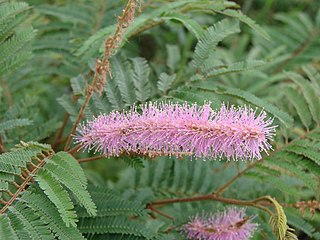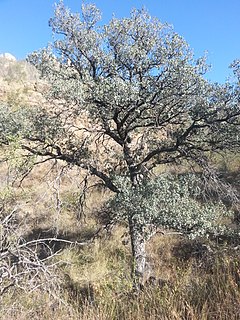
Mimosa is a genus of about 400 species of herbs and shrubs, in the mimosoid clade of the legume family Fabaceae. The generic name is derived from the Greek word μῖμος (mimos), an "actor" or "mime", and the feminine suffix -osa, "resembling", suggesting its 'sensitive leaves' which seem to 'mimic conscious life'.

Mimosa tenuiflora, syn. Mimosa hostilis, also known as jurema preta, calumbi (Brazil), tepezcohuite (México), carbonal, cabrera, jurema, black jurema, and binho de jurema, is a perennial tree or shrub native to the northeastern region of Brazil and found as far north as southern Mexico, and the following countries: El Salvador, Honduras, Panama, Colombia and Venezuela. It is most often found in lower altitudes, but it can be found as high as 1,000 m (3,300 ft).

Mimosa pudica is a creeping annual or perennial flowering plant of the pea/legume family Fabaceae. It is often grown for its curiosity value: the compound leaves fold inward and droop when touched or shaken, defending themselves from harm, and re-open a few minutes later. In the UK it has gained the Royal Horticultural Society's Award of Garden Merit.

The streak-backed oriole is a medium-sized species of passerine bird from the icterid family. It is native to Central America and Mexico and is an occasional visitor to the United States.

Mimosa diplotricha is a species of leguminous woody shrub native to the Neotropics. It is an invasive species and now has a pantropical distribution. It is commonly known as the giant sensitive plant, giant false sensitive plant, or nila grass.
Albizia pistaciifolia is a species of plant in the family Fabaceae. It is found in Colombia, Ecuador, and Venezuela.
Mimosa andina is a species of plant in the family Fabaceae. It is found only in Ecuador. Its natural habitat is subtropical or tropical dry shrubland.
Mimosa disperma is a species of plant in the family Fabaceae. It is found only in Ecuador. Its natural habitat is subtropical or tropical dry forests.
Mimosa loxensis is a species of plant in the family Fabaceae. It is found only in Ecuador. Its natural habitat is subtropical or tropical dry shrubland.
Mimosa townsendii is a species of plant in the family Fabaceae. It is found only in Ecuador. Its natural habitat is subtropical or tropical dry shrubland.

Mimosa verrucosa, commonly known as jurema-branca or jurema-de-oeiras, is a species of legume of the genus Mimosa, in the common bean family, Fabaceae.

Archidendron bigeminum is a tree species in the legume family (Fabaceae). It is found in India and Sri Lanka. It is known as "Kalitiya - කලටිය" in Sinhala people.
Discocharopa mimosa is a species of air-breathing land snails, terrestrial pulmonate gastropod molluscs in the family Charopidae. This species is endemic to Australia.
Beauprea congesta is a species of plant in the family Proteaceae. It is endemic to New Caledonia.

Helicia is a genus of 110 species of trees and shrubs, constituting part of the plant family Proteaceae. They grow naturally in rainforests throughout tropical South and Southeast Asia, including India, Sri Lanka, Indochina, Peninsular Malaysia to New Guinea and as far south as New South Wales.
Helicia amplifolia is a species of plant in the family Proteaceae. It is endemic to Papua New Guinea. It is threatened by habitat loss.
Helicia insularis is a species of plant in the family Proteaceae. It is endemic to Papua New Guinea. It is threatened by habitat loss.
Roupala pinnata is a species of plant in the family Proteaceae. It is endemic to Peru.

Quercus oblongifolia, commonly known as the Arizona blue oak, Blue live oak or Sonoran blue oak, is an evergreen small tree or large shrub in the white oak group.

The Oti Valley Faunal Reserve is a protected area in northeastern Togo, one of four Important Bird Areas (IBA) in the country. The site is mainly savanna and seasonally inundated floodplains on either side of the Oti River. It has a total area of 147,840 hectares and is located at 10°35'N and 0°40'E.










